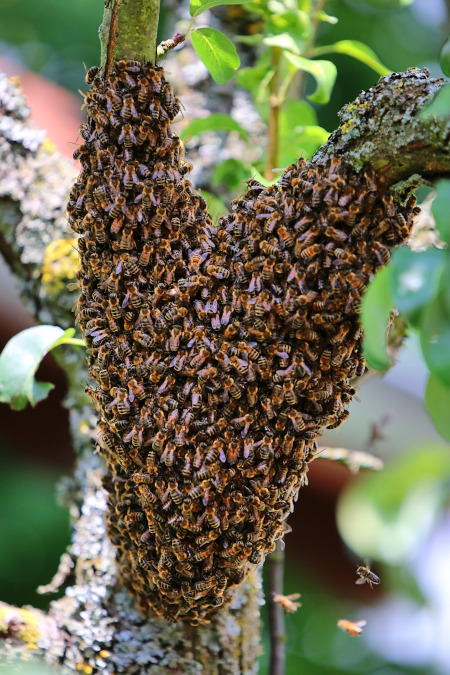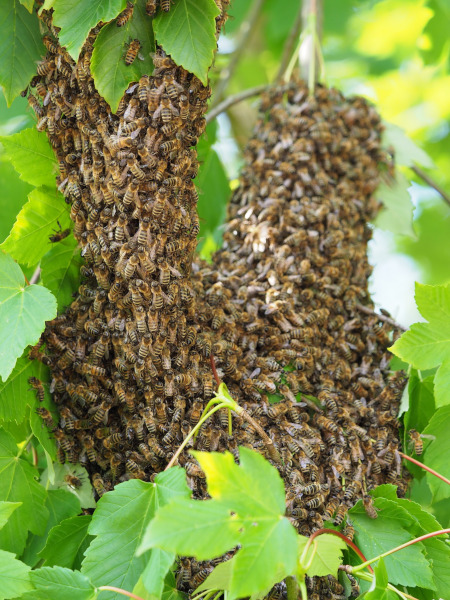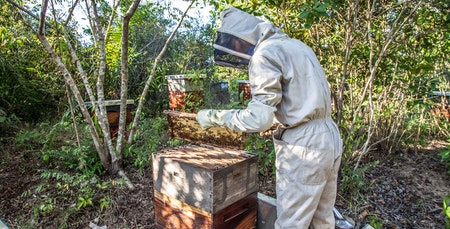Swarming of Bee Colonies
Reproduction of Bee Colonies
In order to achieve high honey production, it is crucial to have a large number of bee colonies. It is even more important to have high total honey production, which requires breeding an adequate number of bee colonies. For beekeepers whose primary occupation is agricultural production, it is recommended to maintain between 40 to 100 beekeeping companies, or more, depending on the number of household members who can and want to work with bees, the size of the property, and the intensity of agricultural production.
It is always better to keep a larger number of bee colonies from an economic standpoint and overall profitability. Some beekeepers keep 200 or more bee colonies and achieve extremely favorable results. Those whose primary occupation is beekeeping keep 600 or more bee colonies.
Natural Reproduction
In the spring, when the large pasture arrives, the queen bee lays more eggs, and the members of the society become more numerous. As the society grows larger and space in the hive becomes limited, the urge to swarm may soon appear. The urge to swarm is influenced by a variety of factors, such as insufficient space for laying eggs and accommodation and processing of nectar and pollen, age of the queen, and excessive heat in the hive. When these conditions are met, worker bees build queen cells.

When the swarm is caught on a branch, it should be cut off, and the bees should be shaken into an empty hive in which the queen lays her eggs, but not all at once, rather in phases or at time intervals. The worker bees begin to feed the larvae in the queen cells and upgrade them very quickly. When the queens are closed, under the influence of worker bees, the queen begins to slow down and even stops laying eggs, preparing for intensive egg-laying in the new bee colony that is already beginning to form. The worker bees that form a new society, and are still in the old hive, completely stop working and feed well. They are generally calm, move poorly, and prepare for the greater activity ahead. The queen, as soon as she stops laying eggs, becomes less fed, and her abdomen and genitals narrow slightly. She becomes faster, lighter, and more agile, all of which she needs to be able to spend time in the air more safely, from the moment she leaves the old hive until she enters the new one.
When the worker bees close the queen cells, the hive becomes more active, agitated, and buzzing, indicating that swarming preparations are nearing completion. Within a day or two, but no more than three, the bees complete their final tasks in the old hive. The newly formed society takes its last meal from the old society, which is the strongest meal a bee will ever have. They eat as much as they can and store as much as they can as a reserve. Swarming bees rarely sting since they are not aggressive. Typically, during the day between 11 am and 2 pm, the bees leave the hive with the old queen, buzzing loudly and in a hurry.
Sometimes the young queen hatches before the newly formed society emerges, but the old queen always leaves with the new society. This fact is important to record the age of the queens. Once the working bees, queens, and drones of the newly formed society leave the hive, they create a large swarm and fly in circles above the beehives in a joyous mood. Interestingly, a significant number of worker bees and drones in the surrounding air join the celebration and increase the whole ceremony. A large portion of these bees become permanent members of the newly formed society.
Many people wonder how there is no conflict between bees from different societies during swarming. However, bees have special olfactory glands that secrete a specific olfactory substance, pheromones, during swarming, which influences bees from different societies to unite into a single society, making them feel as if they have always been part of the same society. Since smells are equalized during swarming, the newly formed society can live normally. After circling over the apiary for some time, the bees gradually move away from the hive, but usually not far. They look for a suitable place near the beehives, typically a branch of a tree, where they land.
Occasionally, the swarm flies away and does not stop near the apiary. To prevent this, beekeepers should have fine sand or a water sprayer at the apiary. When the swarm is estimated to reach the culmination of circling above the apiary, the beekeeper can throw sand on it or spray it with water. The bees immediately start landing in the immediate vicinity, as they feel it is raining, and they are "afraid."
Once the swarm lands on an object, it calms down and stays there for a few hours. During this time, some worker bees go to look for a more convenient place to settle permanently. When they find one, they return and lead the entire colony. The length of time the swarm stays where it lands depends on how long the scouts take to find a new spot, which can take anywhere from half an hour to 24 hours or more. As soon as the swarm calms down, beekeepers should catch it and place it in a hive. Previously prepared and disinfected hives are placed under bees. If the swarm is high and on a tree that cannot be climbed, one or two long poles with ropes are used to shake the branch and place the basket under the tree on a board. If the swarm is caught on a suitable branch, the swarm is transferred together with the branch and shaken into a basket with a moving honeycomb, making the process simpler and more effective.

If a swarm is caught in a suitable location, a beehive can be placed above the bees with a little honeycomb containing honey and even better, a piece of brood. The bees will be smoked and begin to enter the hive as they naturally move upwards. Once all the bees have entered the hive, it can be carefully removed and treated as usual. It's worth noting that a swarm can be caught more easily by placing a frame with honeycomb and litters in a suitable place, which quickly attracts the queen and the brood. The bees from the swarm will not return to the old hive, even if it's placed in front of the hive from which it flew. A bee colony can swarm once, twice, or even three times a year. The first swarm is called the firstborn, the second the second, and the third the third. The firstborn is the strongest, but it often has an old queen that can make it difficult to develop into a normal colony. If a swarm swarms in the same year, then a new swarm is called a pair. If a pair swarms in the same year, then that swarm of pairs is called white bees. The first ones are the best swarms, usually from the fifth month. Later swarms are weaker, so it takes a lot of effort and work to develop and strengthen them. In the bee colony from which the swarm emerged, the urge to swarm is usually soon extinguished. It has a young queen and excellent conditions to recover faster and resume normal life and work. As a rule, as soon as the first queen is made, the other queens are destroyed. However, if more queens are made for any reason, then the bee company leaves one and destroys all the others. Most often, they fight alone, and the weaker one is destroyed, leaving the stronger queen in the society.
However, the increase in the number of colonies should not rely solely on natural swarming for several reasons. First, natural swarming reduces honey yield, primarily because bees become less active in collecting materials and making honey as they prepare for swarming. Societies usually divide at a time when they should be at their strongest. During natural swarming, swarms can escape, and it's not possible to direct natural swarming to the desired time. It's challenging to control queen performance, its quality, and age during natural swarming. All these weaknesses can be eliminated by artificial swarming, ensuring the strength of the colony is maintained, or swarming occurs during the highest honey intake.
How to Perform Artificial Swarming
Artificial swarming is a process used to increase the number of hives in a beekeeping operation. Here's how to do it:
- Transfer six frames from the old hive to a new, prepared hive. Make sure to arrange the frames with brood and honey correctly.
- It doesn't matter which hive the queen stays in, but it's crucial to know which hive she is in. If a hive doesn't have a queen, provide a spare that is already paired.
- Place the hives next to each other, taking up half of the space the old hive was in. The entrance of both hives should be at the same height and facing the same direction as the old hive's entrance.
- Paint both hives the same color so returning bees can easily identify them.
- If returning bees can't find their hive, half of them should go to one hive and the other half to the other hive.
- Keep both hives narrow for a day or two. Then, gradually move them half a meter per day until they are in the desired location.
- This method can be used even if a spare queen isn't available. In that case, transplant queen cells or insert a frame with a honeycomb where the queen is located.
- When the bees notice that there's no queen, they will build a queen cell and produce a new queen.

There are different methods for artificial swarming. One way is to take the appropriate number of bee frames from two, three or more hives, being careful to ensure that there is no queen on them. These frames, along with the corresponding number of frames with young brood and honey, are then placed in empty hives. A fragrant liquid is sprayed on the frames, and a new colony is formed from several colonies that will build queen cells and produce a new queen, or a queen from reserve can be added. Since all the queen bees will return to their parent colonies, the new colony will only have young bees that have not yet hatched from their hive. Therefore, the new colony should be watered, and if there is no honey available, it should be fed.
The Third Method involves moving the queen and a couple of frames with open brood from the original hive (marked as Hive 1) to create a new colony (marked as Hive 2). In Hive 1, a frame with freshly laid eggs and one-day-old larvae is left behind to produce a new queen. In Hive 2, two frames with wax bases and one frame with honey and pollen powder are placed on either side of the frames with brood. Hive 2 is then placed in the spot of a strong colony (marked as Hive 3) and moved at least two to three meters away from its original location. This prompts the honey bees from Hive 3 to fly to Hive 2, which significantly strengthens the newly formed swarm. The original colony (Hive 1) will either produce a new queen or be given one from a reserve, allowing it to quickly develop and strengthen since all the worker bees remain with that colony. Only a portion of the young bees are transferred to Hive 2. Hive 3 will also recover quickly since it has an abundance of brood and a good, fertile queen.
To ensure the health of a swarm, it is crucial to inspect them periodically to check if they have a queen. In some cases, swarms may lose their queen due to different reasons, such as pests or accidental entry into another hive, during mating flights. It is essential to examine the source hive from which the swarm came, as appropriate measures may be required to maintain the health and productivity of the bees. Regular inspections can prevent potential problems and ensure the survival of the swarm.
arrow_upward